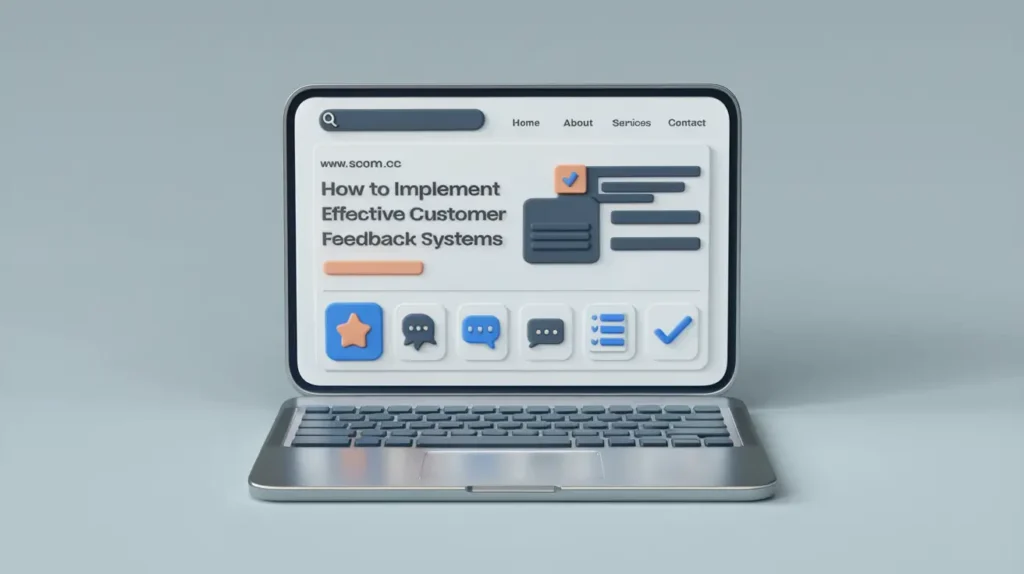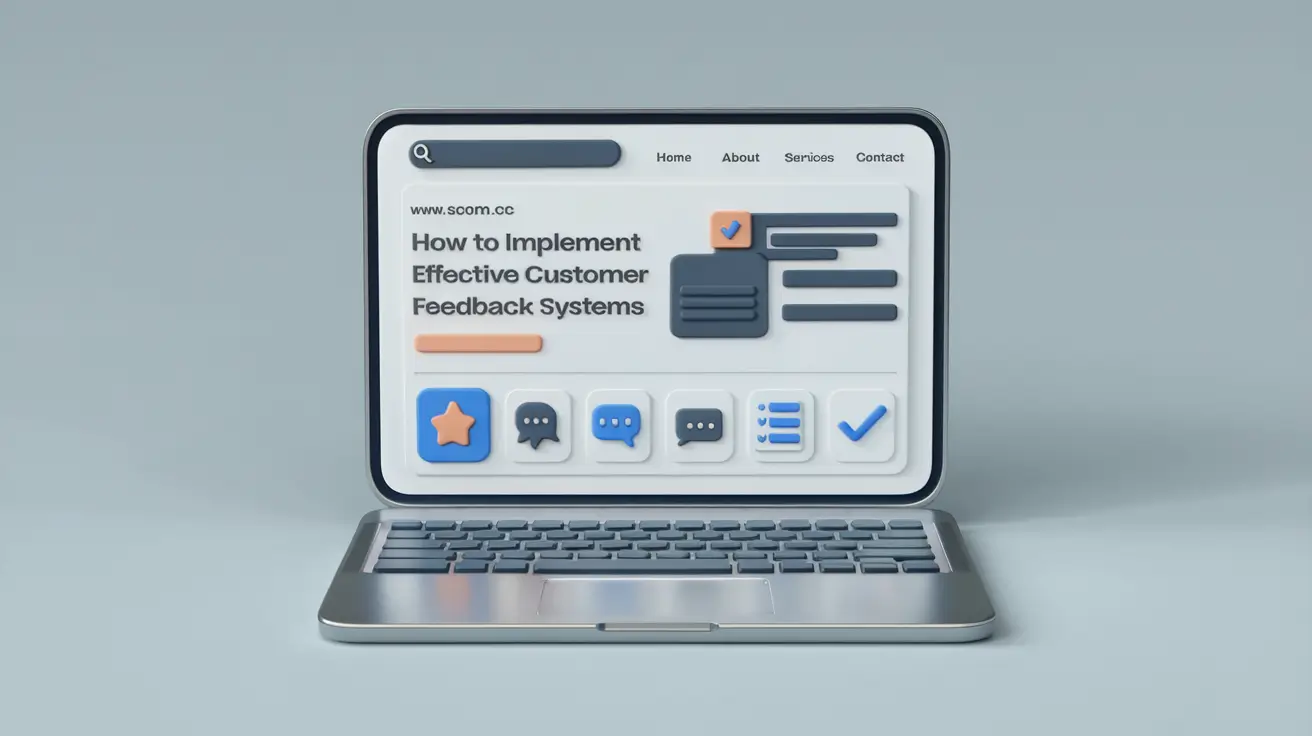How to Implement Effective Customer Feedback Systems

- How to Implement Effective Customer Feedback Systems
- What is a Customer Feedback System?
- Why is a Customer Feedback System Important?
- Key Components of an Effective Customer Feedback System
- Best Practices for Implementing Customer Feedback Systems
- Case Studies of Effective Customer Feedback Systems
- Summary Table
-
FAQ
- What is a customer feedback system and why is it important?
- How can businesses set up an effective customer feedback system?
- What are some common methods for collecting customer feedback?
- How can businesses ensure they are acting on customer feedback?
- What are some best practices for using customer feedback effectively?
- How can businesses measure the success of their customer feedback system?
- Can you provide examples of companies with successful customer feedback systems?
How to Implement Effective Customer Feedback Systems
Implementing an effective customer feedback system is crucial for businesses seeking to enhance their products, services, and overall customer experience. A well-designed feedback system allows companies to gather valuable insights from customers, identify areas for improvement, and make data-driven decisions that drive growth and satisfaction. This article explores how to implement effective customer feedback systems, covering best practices, key components, and strategies for success.
What is a Customer Feedback System?
A customer feedback system is a structured process through which businesses collect, analyze, and act upon feedback from customers. This feedback can be gathered through various channels, including surveys, reviews, social media, and direct interactions. The primary goals of a customer feedback system are to:
- Understand Customer Needs: Gain insights into what customers want and need from your products or services.
- Enhance Customer Experience: Identify and address issues that affect customer satisfaction and loyalty.
- Improve Products and Services: Use feedback to make data-driven improvements to offerings.
- Build Stronger Relationships: Foster positive relationships with customers by showing that their opinions are valued and acted upon.
Why is a Customer Feedback System Important?
A customer feedback system is important for several reasons:
Identifying Areas for Improvement
Feedback provides direct insights into customer experiences and perceptions, helping businesses identify areas where they can enhance their products, services, or processes.
Increasing Customer Satisfaction
By addressing issues and making improvements based on feedback, businesses can enhance the overall customer experience and increase satisfaction levels.
Driving Innovation
Customer feedback can reveal unmet needs and emerging trends, providing valuable information for developing new products or services and driving innovation.
Building Customer Loyalty
A responsive feedback system demonstrates that a business values its customers’ opinions and is committed to making improvements, which can strengthen customer loyalty and retention.
Benchmarking Performance
Feedback systems allow businesses to track performance over time and measure the impact of changes. This benchmarking helps in assessing progress and setting future goals.
Key Components of an Effective Customer Feedback System
An effective customer feedback system consists of several key components:
Feedback Channels
Offer multiple channels for customers to provide feedback, such as:
- Online Surveys: Conduct surveys through email, websites, or mobile apps.
- Feedback Forms: Use forms on your website or within your product or service interfaces.
- Social Media: Monitor and engage with feedback on social media platforms.
- Customer Reviews: Collect reviews from customers on review sites and platforms.
- Direct Interactions: Gather feedback through face-to-face interactions, phone calls, or chat support.
Feedback Collection Tools
Utilize tools and software to collect and manage feedback effectively. These tools may include:
- Survey Platforms: Tools like SurveyMonkey, Google Forms, or Typeform for creating and distributing surveys.
- CRM Systems: Customer Relationship Management systems that integrate feedback collection and analysis.
- Feedback Management Software: Specialized software for tracking and analyzing customer feedback.
Feedback Analysis
Analyze the feedback to identify trends, patterns, and areas for improvement. Key steps include:
- Categorization: Group feedback into categories or themes to simplify analysis.
- Quantitative Analysis: Use statistical methods to analyze survey results and numerical data.
- Qualitative Analysis: Analyze open-ended feedback to uncover detailed insights and sentiments.
Actionable Insights
Translate feedback into actionable insights that can drive improvements. This involves:
- Prioritization: Determine which issues or suggestions are most critical to address.
- Action Plans: Develop specific plans for implementing changes based on feedback.
- Responsibility Assignment: Assign tasks and responsibilities to team members for executing the action plans.
Communication and Follow-Up
Communicate with customers about the actions taken based on their feedback. This includes:
- Acknowledgment: Thank customers for their feedback and let them know their input is valued.
- Updates: Inform customers about the changes or improvements made in response to their feedback.
- Continuous Engagement: Maintain an ongoing dialogue with customers to gather further feedback and keep them informed.
Feedback Integration
Integrate feedback into your overall business strategy and processes. This involves:
- Process Improvement: Incorporate feedback into operational processes and workflows.
- Product Development: Use insights to guide product or service development and enhancements.
- Customer Experience: Apply feedback to improve customer interactions and experiences.
Performance Tracking
Monitor the effectiveness of the feedback system and track key performance indicators (KPIs), such as:
- Customer Satisfaction Scores: Measure changes in customer satisfaction over time.
- Net Promoter Score (NPS): Track changes in customer loyalty and likelihood to recommend.
- Feedback Response Rates: Monitor the number of responses and engagement levels.
Best Practices for Implementing Customer Feedback Systems
To ensure the effectiveness of your customer feedback system, follow these best practices:
Set Clear Objectives
Define clear objectives for your feedback system, such as improving customer satisfaction, enhancing product features, or increasing loyalty. Align your feedback collection and analysis efforts with these objectives.
Make Feedback Collection Easy
Simplify the feedback collection process to encourage participation. Use user-friendly tools and minimize the time required to provide feedback.
Ensure Feedback Anonymity
Provide options for anonymous feedback to ensure that customers feel comfortable sharing honest opinions without fear of repercussions.
Act on Feedback Promptly
Respond to feedback in a timely manner and take action to address issues or implement suggestions. Demonstrating responsiveness reinforces the value of customer input.
Foster a Feedback Culture
Promote a culture of feedback within your organization by encouraging employees to seek and act on customer input. Integrate feedback into regular business practices and decision-making.
Regularly Review and Update the System
Continuously review and update your feedback system to ensure it remains effective and relevant. Make improvements based on user experiences and changes in business needs.
Train Employees
Train employees on how to use the feedback system effectively and how to handle customer interactions related to feedback. Provide guidance on analyzing feedback and implementing changes.
Case Studies of Effective Customer Feedback Systems
Amazon's Customer Feedback Approach
Amazon is known for its robust customer feedback system, which includes customer reviews, ratings, and surveys. The company uses this feedback to improve its product offerings, enhance customer service, and optimize the user experience. Amazon’s commitment to acting on feedback and communicating changes has contributed to its success and customer loyalty.
Starbucks' My Starbucks Idea Platform
Starbucks has implemented the My Starbucks Idea platform, where customers can submit ideas, vote on suggestions, and provide feedback. This platform allows Starbucks to engage with customers directly and gather insights on new product ideas and improvements. The company has successfully implemented several customer-driven ideas, demonstrating the value of an interactive feedback system.
Zappos' Customer Service Excellence
Zappos, an online shoe and clothing retailer, places a strong emphasis on customer service and feedback. The company actively seeks customer feedback through surveys, social media, and direct interactions. Zappos uses this feedback to refine its service processes, enhance the shopping experience, and build strong customer relationships.
Summary Table
| Question | Key Points |
|---|---|
| What is a customer feedback system? | A structured process for collecting, analyzing, and acting upon customer feedback to enhance products, services, and customer experience. |
| Why is a customer feedback system important? | It helps identify areas for improvement, increase customer satisfaction, drive innovation, build customer loyalty, and benchmark performance. |
| What are the key components of an effective customer feedback system? | Feedback channels, feedback collection tools, feedback analysis, actionable insights, communication and follow-up, feedback integration, and performance tracking. |
| What are the best practices for implementing a customer feedback system? | Set clear objectives, make feedback collection easy, ensure anonymity, act on feedback promptly, foster a feedback culture, regularly review and update the system, and train employees. |
| What are some examples of effective customer feedback systems? | Amazon's customer feedback approach, Starbucks' My Starbucks Idea platform, and Zappos' customer service excellence. |
FAQ
What is a customer feedback system and why is it important?
A customer feedback system is a structured process for gathering, analyzing, and acting on customer feedback. It is important because it helps businesses understand customer needs, enhance satisfaction, drive innovation, and build stronger relationships.
How can businesses set up an effective customer feedback system?
Businesses can set up an effective feedback system by defining clear objectives, offering multiple feedback channels, using appropriate tools, analyzing feedback, and implementing actionable insights. Communication with customers and integration of feedback into business processes are also key.
What are some common methods for collecting customer feedback?
Common methods include online surveys, feedback forms, social media interactions, customer reviews, and direct interactions such as phone calls or face-to-face meetings.
How can businesses ensure they are acting on customer feedback?
Businesses can ensure they are acting on feedback by prioritizing issues, developing action plans, assigning responsibilities, and communicating changes to customers. Regularly reviewing the effectiveness of actions taken is also important.
What are some best practices for using customer feedback effectively?
Best practices include setting clear objectives, making feedback collection easy, ensuring anonymity, acting promptly on feedback, fostering a feedback culture, regularly reviewing and updating the system, and training employees.
How can businesses measure the success of their customer feedback system?
Businesses can measure success by tracking key performance indicators such as customer satisfaction scores, Net Promoter Score (NPS), feedback response rates, and the impact of changes made based on feedback.
Can you provide examples of companies with successful customer feedback systems?
Examples include Amazon's comprehensive feedback approach, Starbucks' interactive My Starbucks Idea platform, and Zappos' emphasis on customer service and feedback. These companies effectively use feedback to drive improvements and enhance customer experiences.

If you enjoyed this article and found it valuable, we encourage you to explore our news and valuable information section, where you'll find more relevant and up-to-date content that may pique your interest. Additionally, if you are seeking advice or need guidance on a specific topic, we suggest visiting our services section. There, you will find a variety of options designed to assist and support you in addressing your needs. Feel free to check out both sections to get the information and assistance that best suits your requirements.

Leave a Reply